MAGIC Morphs Into New Normal as Live Show Returns

LAS VEGAS — It was definitely not the same old MAGIC.
Informa Markets Fashion took the plunge and returned to the Las Vegas Convention Center with an in-person event for its biannual MAGIC, Project and Sourcing shows this week. But the pandemic continued to have a major impact on the number of exhibitors and attendees.
More from WWD
In 2019, before COVID-19 shut down the world, Informa had revealed that it was going to bring all of its shows together under one roof at the LVCC, which was undergoing an $860 million expansion. For the past several years, the women’s and footwear shows were at the convention center while Project and MAGIC Men’s were at the Mandalay Bay.
All told, Informa’s shows, which included Pool and others, spanned some 800,000 square feet prior to the pandemic. Informa management declined to say how much space the August show took up, the number of exhibitors versus the last live show in February 2020 or provide a count of retailer attendance.
The pandemic caused the last two editions of the show to be virtual and the decision to return to Vegas was seen as a positive sign that the industry was getting back to a sense of normalcy. But most of the large exhibitors — including AG, Tommy Bahama, Peerless and Levi’s, as well as the major retailers — still took a pass.
Kelly Helfman, president of Informa Fashion Markets, attributed that to travel freezes that kept employees from both vendors and merchants from making the trip. “But they plan to come back in 2022 in a more-traditional way,” she predicted.
The “silver lining” to the lack of big brands was that it provided new and smaller labels the opportunity to be showcased, she added. Helfman said 33 percent of the brands at Project and 25 percent at MAGIC were new.
Women’s MAGIC, which was housed in the new West wing of the LVCC — accessible by complementary Tesla vehicles, which drove through a tunnel that felt like a bobsled run — had a lot of energy.
But with the exception of the streetwear brands, the men’s show was fairly bleak in comparison. Part of the problem is that Vegas overlapped with the Chicago Collective, which is fast becoming a must-visit show for many in the contemporary men’s industry, as well as a rescheduled Outdoor Retailer event in Denver.
Helman admitted that was a problem for this edition, but said going forward, Informa will work closely with the organizers of the other shows to ensure they are not held at the same time.
Liberty Fairs, which has shown in Vegas at the same time as MAGIC for the past several years, opted to host a show in Los Angeles earlier this month and the PGA Show held its biannual trade show at a golf club outside of town. Only Agenda — which was small and displayed mainly T-shirts and hoodies at the Bally’s Convention Center — and the Off-Price Show also took place on the Strip.
For retailers who did not make the trip to Vegas, Helfman said Informa will offer a virtual option. “We love live events but we will forever be hybrid,” she said. Brands that exhibited at the show will eventually be available on what she called “a digital discovery platform.”
Even so, Helfman is hopeful that 2022 will be strong for Informa’s in-person events. “It’s hard digitally,” she said. “People want to be back face-to-face to discover new brands and touch and feel the merchandise.”
Among the regulars who did attend was the Doneger Group, but the group was smaller and the company didn’t hold its opening-day trend presentation — historically popular with its retail members.
Patty Leto, Doneger’s senior vice president of merchandising who oversees men’s wear, said the decision to forego the presentation this time was a function of the team being scattered across the overlapping shows. “We had to spread our resources and make sure we were catching all our clients,” she said.
But both at Project and the Chicago Collective, Leto said the overriding message of the season for men is “comfort across the board. We’re easing him out of his COVID-19 athleisure wardrobe and introducing his re-entry into the workplace wardrobe with the same features and benefits he has been enjoying.”
Retailers need to keep that in mind while helping their customers “polish” their look and “pull it all together and figure out how to take him from home to office to going out,” Leto said.
Among the most-popular categories right now is tailored clothing, both tuxedos and event suits, she said, as people start socializing at events and weddings again. “We expect that to continue through the fall and holiday,” she said.
While supply chain challenges remain, leading to lean inventories and rising prices, retailers should be prepared to address a “very engaged consumer” and the “pent-up demand” he’s experiencing as he seeks to “update his wardrobe. He hasn’t bought anything in 18 months and the early read on fall sales is positive,” Leto said. Despite rising prices, all indications are that the consumer is willing to spend more for pieces with performance and technical attributes that can be worn for many occasions.
Leto said that although she doesn’t cover women’s, that business is strong as well with shoppers responding to similar trends in the market.
Here are some of the top men’s and women’s brands from the recently completed MAGIC and Project, which wrapped up its three-day run on Wednesday.
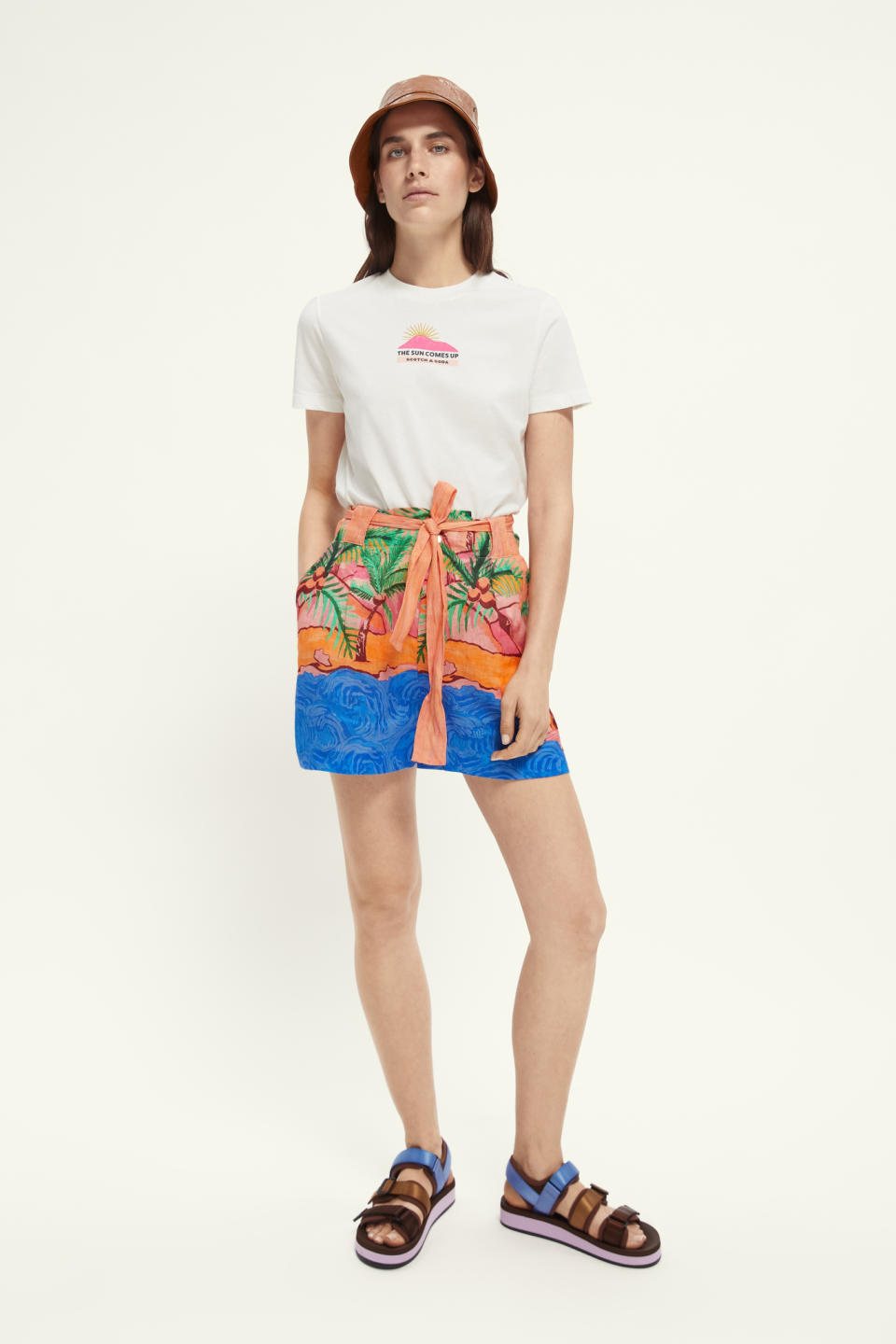
Courtesy Photo
Brand: Abel Macias x Scotch & Soda
Designer: Scotch & Soda
Backstory: For the spring season, Amsterdam-based ready-to-wear label Scotch & Soda tapped artist Abel Macias to design a capsule collection of men’s, women’s and kid’s fashions set to debut in April 2022. Macias, an alumnus of Savannah College of Art & Design, is a painter, muralist, illustrator, builder, maker, art director and “a visual problem-solver,” currently based in Los Angeles, the brand noted. His works are influenced by nature, landscapes, handmade Mexican folk art and everyday objects, injected with upbeat colors, playful textures and patterns. For the collaboration, Macias handcrafted each statement print with a cheery palette in mind, as seen across the assortment of artful casualwear.
Key styles: The capsule includes 32 ready-to-wear styles spanning across men’s (seven styles), women’s (10) and kids (15). The collaboration’s designs are based on a drawing Macias created of the repeating words “the Sun will come up” written on a piece of paper, which was interpreted into graphic artworks of colorful palm trees and cacti, desert landscapes, vibrant sunsets, primary shapes emulating the optimism of summer. “It became more of a piece of art based on text that almost became a mantra. Things that happen in the past, you have to leave them here because there’s always an opportunity for tomorrow to be another day, and a different day with a brand new outcome,” Macias stated in video created for the capsule. Graphic, relaxed T-shirts make up a majority of the capsule across categories (especially key in men’s alongside a swim short, button-up shirt and relaxed sweatshirt); women’s key styles also include beachy sarongs, bandana scarves, shorts, placement print shirts and a kaftan dress.
Retail prices: Styles start at $58 and go up to $198; the brand’s mainline starts at $58 and goes up to $1,298.
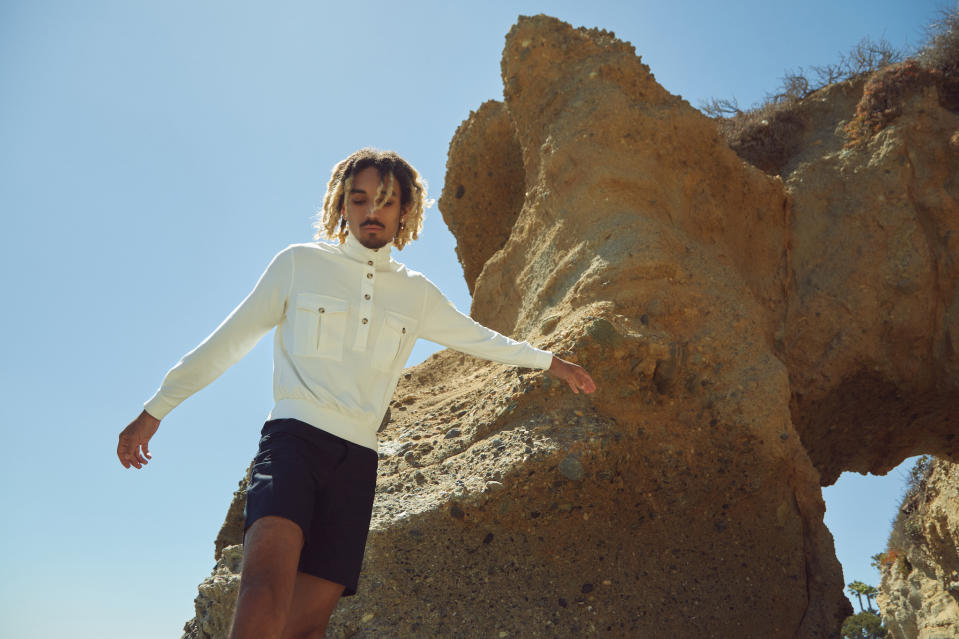
Courtesy Photo
Brand: Alexandria
Designer: Alexander Grubka
Backstory: Michigan State’s loss is the fashion industry’s gain. The founder and designer of Alexandria dropped out of college to move to L.A. and create a fashion collection centered around high-end seersucker sets and washed fleece pieces created for specific settings, such as days on the beach on Long Island or nights in Miami. Although launched as a men’s brand, many of the pieces such as the drawstring shorts and polo shirts also work for women. Alexandria’s showing at Project marked the brand’s first move into wholesale and it was targeting elevated independent stores that are best suited to explain the nuances of the line to their customers, Grubka said.
Key styles: The seersucker sets are a mainstay of the line and are created from Japanese fabrics, while the shorts are double-lined for comfort. The cotton in the hoodies and sweatpants is all organic and the fleece is garment dyed. A polo shirt with tiny eyelets is a key piece and a beach short with a shorter and airy silhouette and an elastic waist, is an addition this season. While the main collection doesn’t have any logos or branding, Grubka offered up a football jersey with the brand name on the back and a soccer-inspired patch on the front as “a fun branding tool,” he said.
Retail prices: The T-shirts retail for $96, the hoodies are $175 and the seersucker sets are $150 to $200.
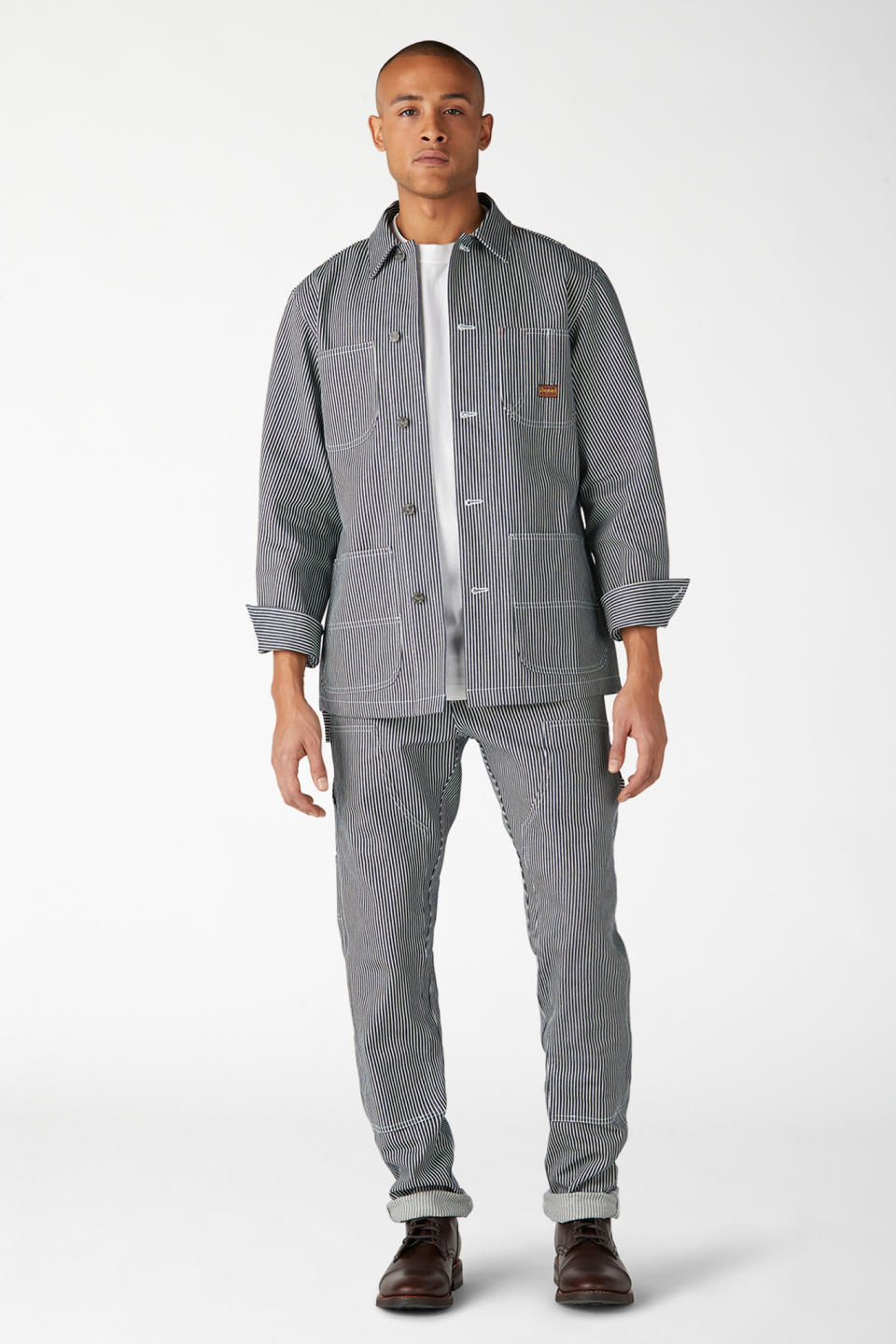
Courtesy Photo
Brand: Dickies 1922
Backstory: The creation of the elevated, heritage collection has been a labor of love for Ann Richardson, the brand’s chief archivist, for the past decade. Her knowledge of the most-intricate details of the brand’s signature styles is encyclopedic. From the Dickies name on a button from the 1930s to the side entry on a pocket designed to hold a pocket watch on a 1928 chore coat, Richardson and her team have re-created some of the best-known pieces from the workwear brand that traces its history to 1922.
Key styles: The limited-edition collection includes the chore coat, utility jeans in a brown duck fabric with a chaps front and hammer loops and a matching work shirt, a chambray shirt in Japanese selvage denim, a hickory striped railroad engineer’s coat and pants, heavy 13.5 ounce denim jeans with a button-fly and a short-sleeve seersucker, plain-front shirt with a convertible collar.
Retail prices: The collection, which is sold at high-end independent stores such as Fred Segal, sells for $148 for short-sleeve shirts, $188 for long-sleeve shirts, $178 or $198 for pants and around $250 for jackets.
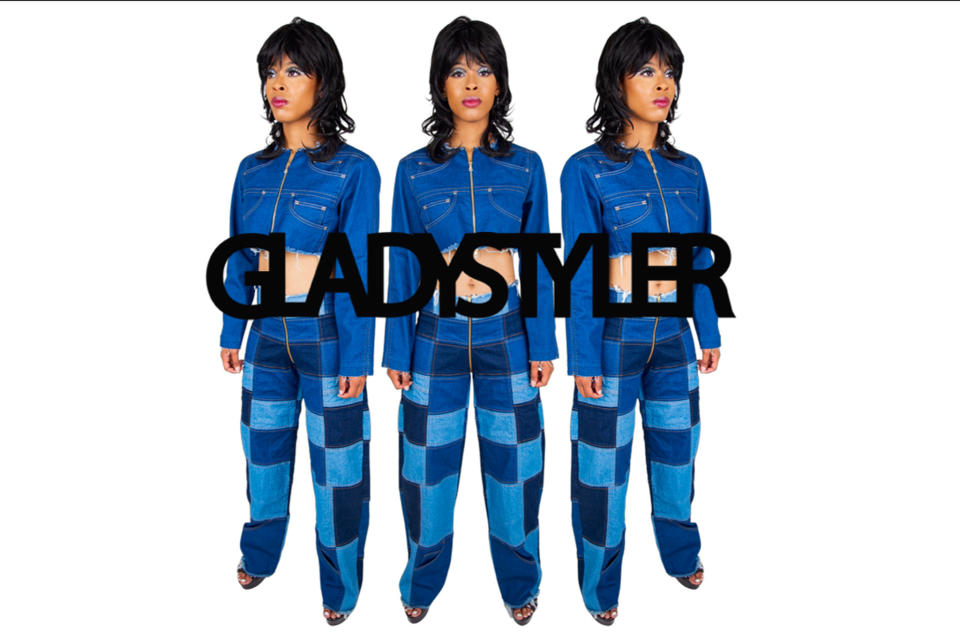
Courtesy Photo
Brand: Gladys Tyler
Designer: Tyler Marie Shumpert
Backstory: The women’s streetwear brand was founded by Shumpert in 2018 in Grand Rapids, Mich., following her graduation from Central Michigan University, where she studied fashion merchandising and design. The brand’s signature style — the patchwork jean — was initially designed and developed during Shumpert’s senior year. “I hear a lot of girls around age 16 to 25 say men’s wear is always cooler; when they say that, I believe they’re referring to streetwear, garments with structure — wanting to be sexy but a coolness. That’s a very big why for this brand,” Shumpert told WWD of the brand’s aesthetic. Since the company’s inception, the sole owner and designer has hand-sewn and altered each garment and currently releases in drop model as she slowly builds out new collections and styles. Shumpert’s spring ’22 collection marks the brand’s trade show debut.
Key styles: Utilitarian meets DIY meets streetwear fashions. Patchwork denim styles, developed in Los Angeles, ranging from “stacked pocket” shorts and pants to cropped jackets and skirts. Each style can be zipped on and off to wear with matching styles in alternative colorways. Spring marks the debut of Shumpert’s velvet fashions, which are developed in Lansing, Mich., by local manufacturer Michigan Fashion Proto.
Retail prices: Retail prices start at $170 and go up to $495.
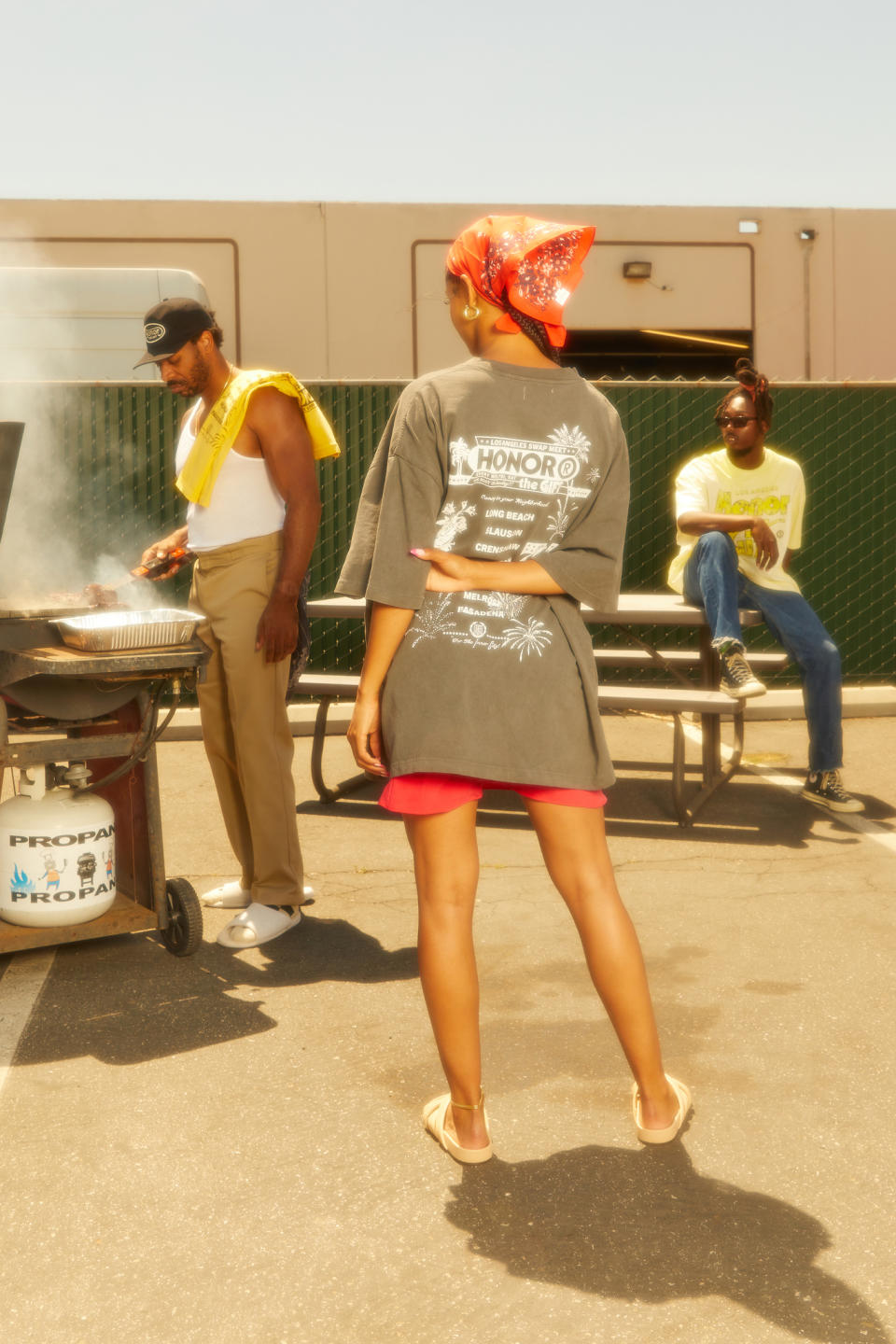
Courtesy Photo
Brand: Honor the Gift
Backstory: It was the fall of 2017 when NBA star Russell Westbrook took the wraps off his inaugural streetwear collection, Honor the Gift, which is his motto and is intended to celebrate the gifts that he has been given. Westbrook, who is known for his fashion sense and partnerships with True Religion, Nike’s Jordan Brand and others, created the line to offer affordable fashion and connect with inner city youth. The phrase “inner city” is one of the major motifs on the line, along with the year 1988, which is when Westbrook was born. Originally a unisex line, Honor the Gift expanded into women’s and children’s wear earlier this year. The line started as online only but is now sold at Nordstrom, Bloomingdale’s, Selfridges and specialty stores such as Union. According to his sales director, Chris Josol, the brand will open its first store on LaBrea in Los Angeles next year.
Key styles: The brand brought its holiday collection to Project, which included a wide range of graphic cut-and-sewn Ts. The top-selling model, Josol said, is a T-shirt that says Inner City Love and Los Angeles. In addition to the Ts, the line offers hoodies, denim, outerwear and even a collection of hats and socks. Women’s-specific silhouettes include sweats with cropped hoodie tops.
Retail prices: The T-shirts sell for $45, the bottoms are $100 and the hoodies are $120. Outerwear is $180 to $250, hats retail for $50 and socks for $15.
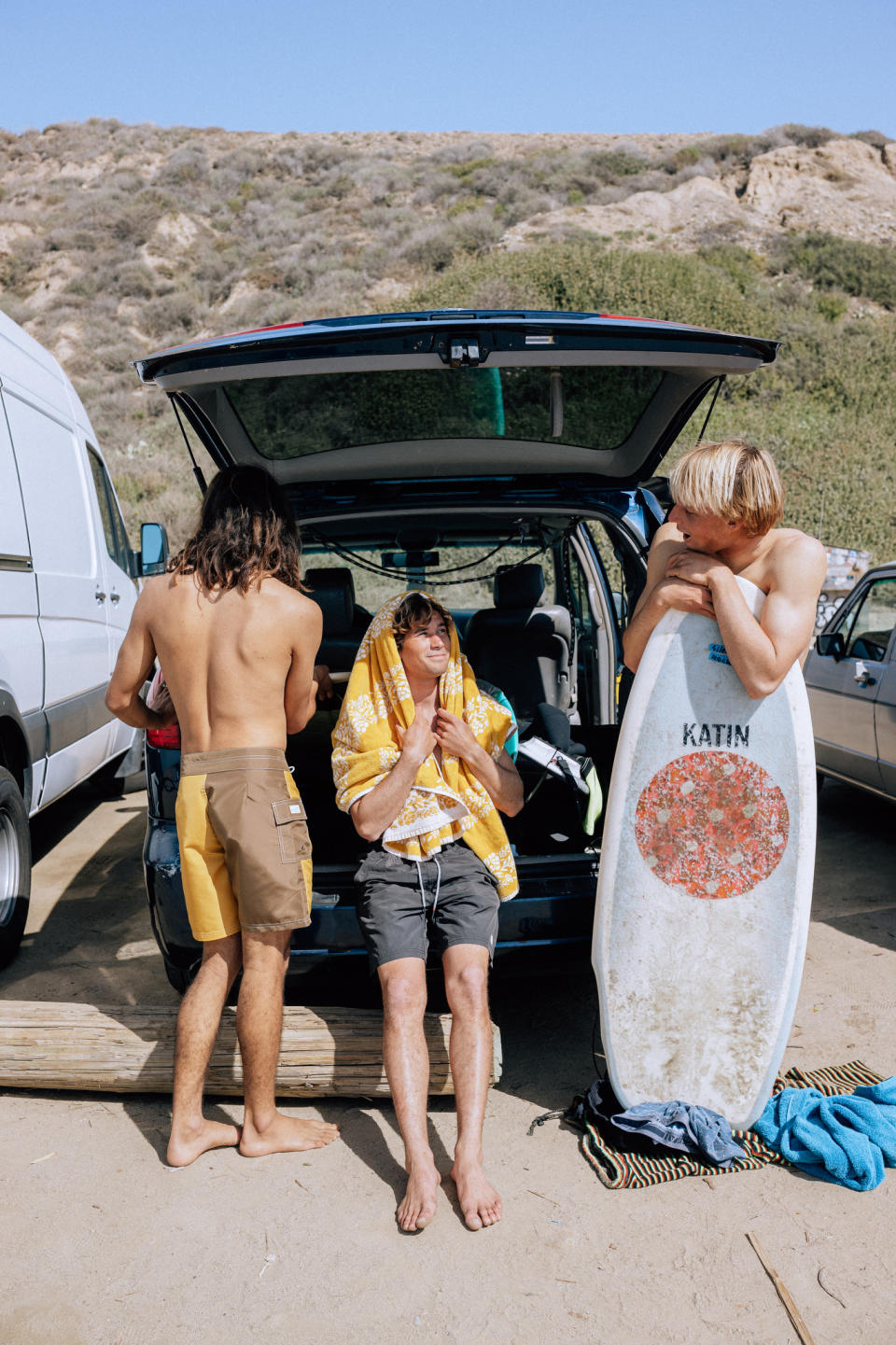
Courtesy Photo
Brand: Katin
Backstory: In 1954, Nancy and Walter Katin were creating canvas boat covers in the beach town of Surfside, Calif. They started getting requests from the local surfing community to create surf trunks. They included Corky Carroll, widely viewed as the world’s first professional surfer. In 1961, the Katins hired Sato Hughes, a young Japanese seamstress who was working at a local dry cleaner, to help them keep up with the demand. The business grew and when the Katins, who were childless, passed away, they left the business to Hughes, who is still active today at the age of 93. She eventually partnered with Mac Beu, who serves as president of the brand and helped expand Katin beyond surfwear into a full four-season lifestyle brand with more than 600 accounts around the world.
Key styles: The core mission of Katin has remained the same since its founding more than 60 years ago: quality, durability and authenticity. For the spring ’22 collection, walk shorts and its derivative, the corduroy trails short, are among the most popular items. The company’s trademark surf shorts feature snap-fly closures, a hallmark of the brand, and are all finished with clean French seams. They come packaged in drawstring pocket bags in the same pattern as the shorts, and a banana boat key chain. Cotton-linen button-down shirts, and the original Waterman short in heavyweight nylon are also top sellers,
Retail prices: Surf shorts retail for $62, the trails short is $55, graphic tees are $32, an embroidered hoodie is $72 and caps sell for $30.
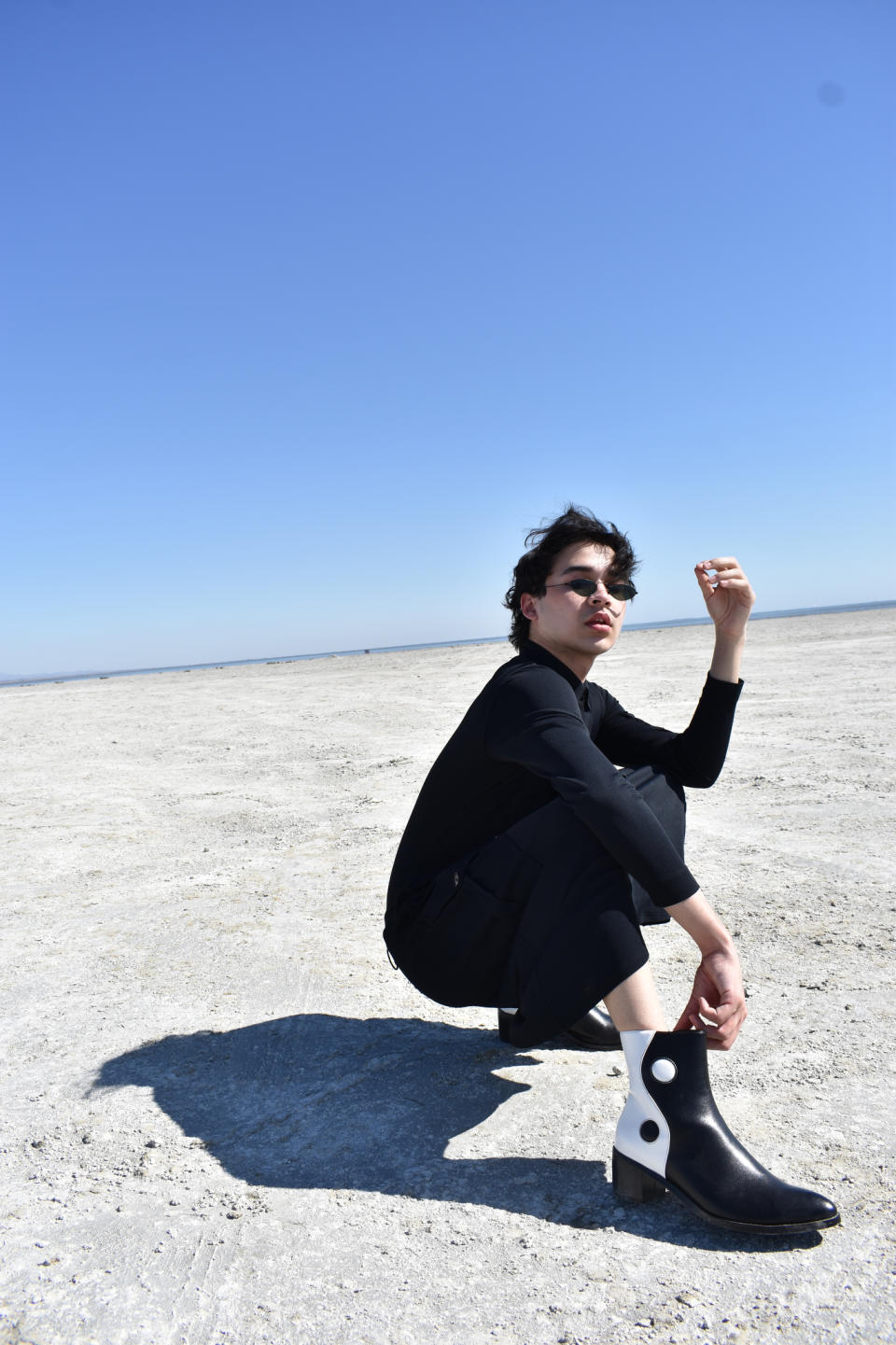
Courtesy Photo
Brand: MCLC
Designer: Jacqueline Velasquez
Backstory: The designer, born and raised in Los Angeles with Guatemalan roots, founded MCLC in 2018 as an apparel company while being a stay-at-home mom, following her 10-plus years of industry experience as a footwear designer. In the midst of the pandemic in 2020, Velasquez pivoted the company into a unisex footwear brand with designs rooted in happiness and inclusivity. The woman-owned, Latina footwear brand is committed to giving a portion of sales to nonprofit organizations, while working sustainably with suppliers to create small batches to reduce fabric and material waste in Los Angeles.
Key styles: “Balancing Act” footwear — knee-high and ankle boots, loafers, platform sandals — sporting yin-yang designs in vegan leather. Velasquez noted she is looking more into alternative sustainable leathers for future collections. “During the pandemic, I got into the creative mode and wanted to connect with people the way I knew how, which was design. That’s when the balancing act collection came about. It really reflected a lot with what was going with everyone’s lives at the moment and became my best seller. From there, everything else grew,” the chief executive officer, founder and designer told WWD.
Retail prices: Retail prices currently range from $95 to $200.

Courtesy Photo
Brand: Naked Rebellion
Designer: Jessica Wenger McPhaul
Backstory: A costume designer by trade with over 17 years of experience, Wenger McPhaul noticed a lack of inclusive nude underpinnings while working in film and TV. Following her experience working on “Dancing With the Stars” over 10 years ago, the idea to design power-mesh intimates was brought to light. Fast forward to 2019, Wenger McPhaul was living in Phoenix, and ready to design an intimates label as an answer to the industry’s needs. From January to July, she developed what would become Naked Rebellion. “I met with all my friends that are in makeup in the film industry and said, ‘Pull out the top shades you use, help me pick which to use,’” Wenger McPhaul told WWD. “That’s how we got to our nine; we hand-dye our mesh and that’s how we launched this brand.” Wenger McPaaul used her industry knowledge, as well as personal insight as a woman and mother, to develop each style with support and inclusivity in mind. The brand is not only female-owned and founded with the message of “Every woman on earth“, but also domestically produced at a woman-owned factory in Los Angeles.
Key styles: Undergarments — bras and underwear — in power mesh and nylon in sizes XS to 3XL. Bras range from bralettes and racerback silhouettes to longer-line, more supportive tank bras while underwear comes in high-waisted, brief and thong styles. The brand also debuted reversible bodysuits within the latest collection.
Retail prices: Bras retail for $68; underwear ranges from $22 to $34; reversible bodysuits for $98. The brand also offers accessories (scrunchies, nude boob tape, masks, gold fill charm necklaces, etc.) from $10 to $74.
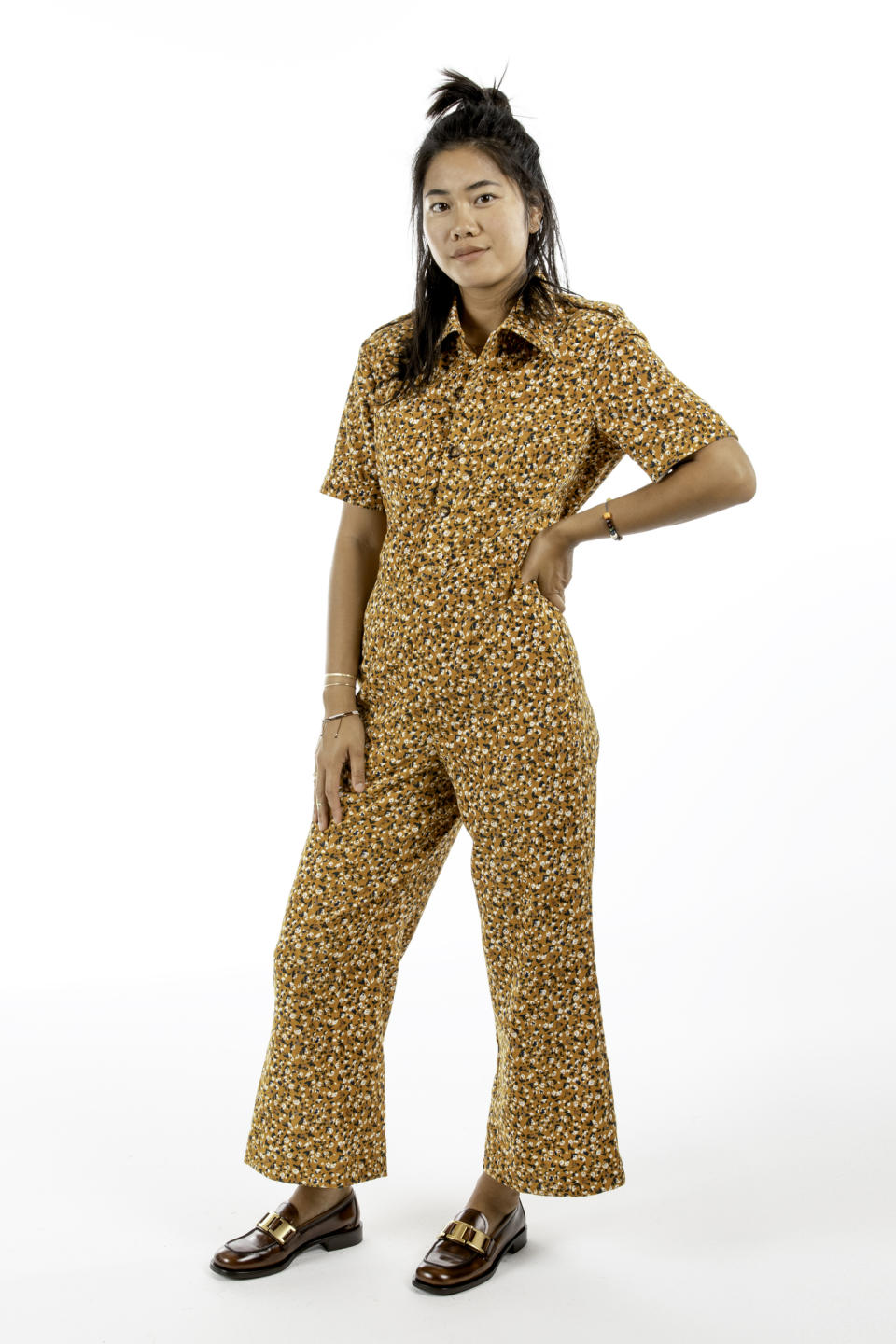
Courtesy Photo
Brand: Saint Geraldine
Designer: Design Team
Backstory: Saint Geraldine is a year-and-a-half old, woman-owned fashion brand based out of Los Angeles. It focuses on sustainable deliveries and is geared more toward the buy-now model with a focus on reducing needless fabric consumption and overproduction (the label showed fall ’21 at the trade show). Additionally, the women’s wear label works with ethical companies in China for production, as well as woman-owned and smaller local manufacturing for its cut-and-sew fashions.
Key styles: For fall: novelty knits, vintage-inspired dresses (floral, striped and kitschy-printed house dresses, etc.), super-stretch cords, double-knit pull-on pants (in a checkerboard print for fall), corduroy overalls and playsuits in fun colors, were all noted as key styles. Overall, the brand strives to design easy, relaxed fashions with a vintage-inspired, playful spirit.
Retail prices: Super-stretch cords around $49; dresses from $80 to $120. Overall, retail prices go up to $150.
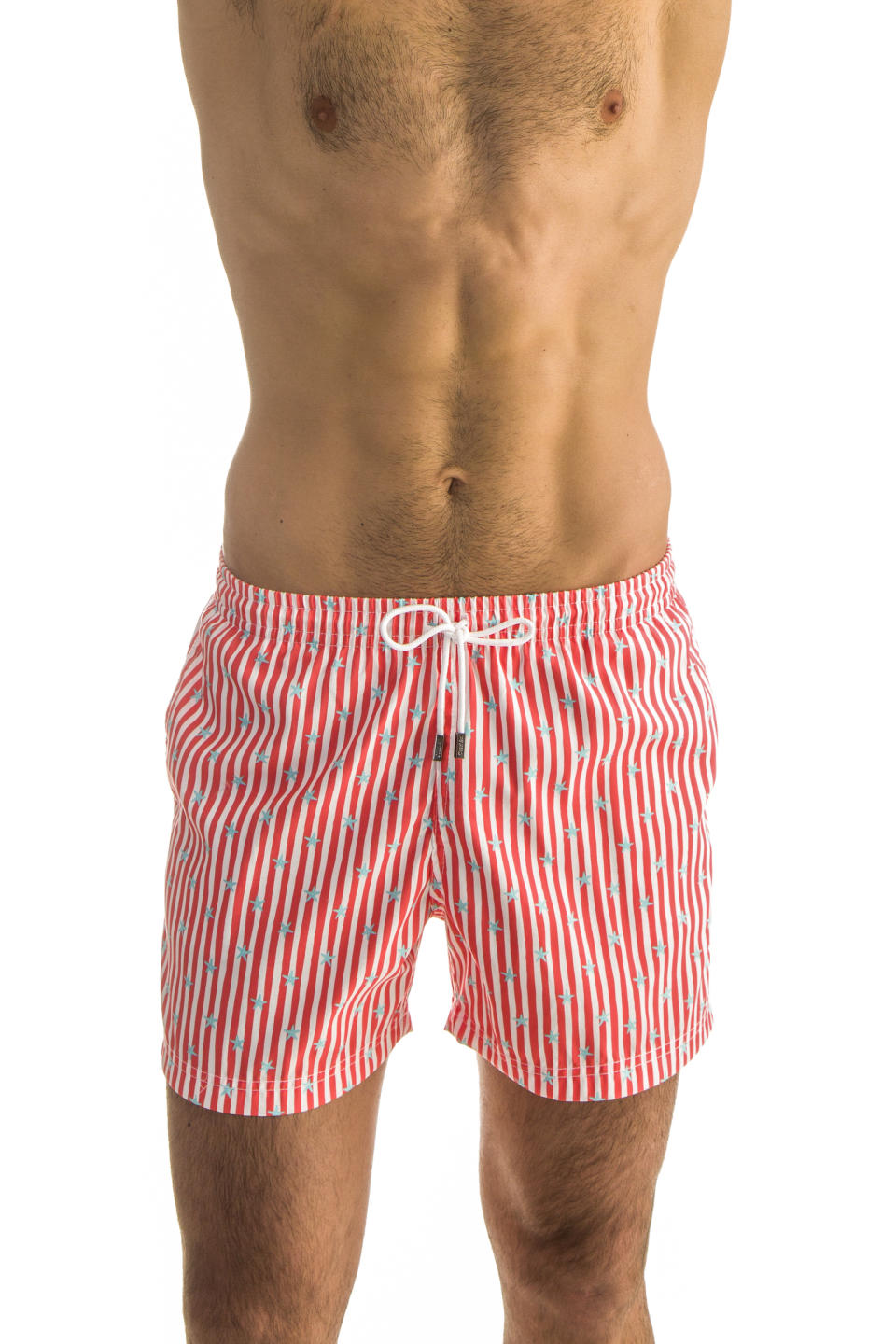
Courtesy Photo
Brand: 98 Coast Av.
Backstory: The company is a family affair. The swimwear and beachwear brand was created in Mexico City in 2011, starting with women’s and girls and later expanding into men’s and boys. Its claim to fame is its matching sets for fathers and sons or mothers and daughters in colorful patterns. The brand operates 40 stores around the world, ranging from Israel and Dubai to the Dominican Republic, Costa Rica and Aruba.
Key styles: The cruise men’s collection offered up a wide range of prints centered around florals and bright colors. The entire line is manufactured in Spain and Mexico and the pieces are lightweight, quick drying and soft to the hand and feature a European cut. In addition to swimwear, the brand offers complementary pieces such as linen shirts, pants and shorts along with a wide range of accessories including waterproof shoes, bamboo sunglasses, towels, pool floats and caps.
Retail prices: The men’s swimwear retails for $89 and the boys’ line is $65.
Launch Gallery: Trends From Magic Trade Show Spring 2022
Sign up for WWD's Newsletter. For the latest news, follow us on Twitter, Facebook, and Instagram.

